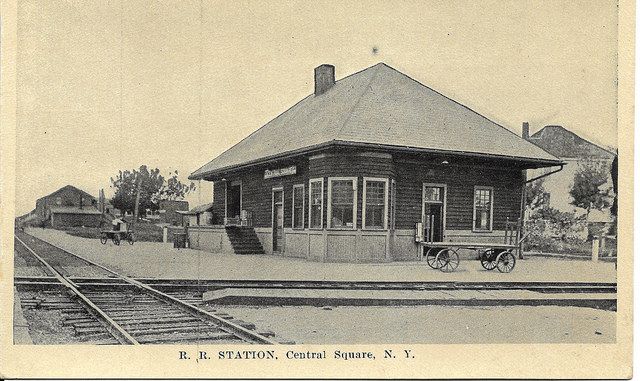Village Historian, Heather Stevens explains how plank roads were developed in the area.
On account of the imperfect condition of the earliest town records it is impossible to ascertain the exact date on which the first roads in the Town of Hastings were laid out. It is known however that there were a lot of surveys made between 1815 and 1830. We do know that Central New York has the distinction of being the site of the first plank road in the United States; the first of what would become a common type of road construction. The road extended from Salina, at the same intersection where Crouse-Hinds was later built, to the Village of Central Square. Construction of this road began in 1845 and was completed in July 1846. The Plank Road roughly followed the path that Native Americans had used to travel from Pennsylvania to the St. Lawrence River. They had called this footpath the Thousand Island Trail. Later, the New York State Legislature had the same route cleared, calling it the Salt Road northward from Salina. The farmers with contiguous lands were taxed for the construction of the road, and were also expected to maintain it.
The Salina-Central Square plank-road company was chartered April 12, 1844 for 30 years with capital of fifty thousand dollars. William D. Bennet was chosen as President and Richard Adams was secretary. The first directors of the road were: Miles W. Bennett, Thomas G. Alvord, Richard Adams, George Geddes, Cramus Johnson, John VanBremner, Henry S. Conde, Amos P. Granger and Moses D. Burnet. The directors celebrated the opening of the plank road on Tuesday August 11 by taking a ride over it in a stage coach party. Construction of this road was only undertaken after the directors of the company had dispatched Thomas G. Alvord and George Geddes of Syracuse to Canada to study the details of construction of a plank road which had already been constructed there. The results of their investigation as reported to the directors follows: ” In conclusion we think it is demonstrated beyond a doubt that an 8 foot track of plank road makes a more substantial, solid and permanent road bed then any other greater width can make that two stringers stout enough to hold a pin of size sufficient to keep the plank in place is all that is necessary; that great care and precaution should be used in so preparing the earth, that the plank should at all point bear equally on the stringers and earth; That the road sides should be so graded as to be elevated slightly at all times above the ends of the plank; that the plank should be kept covered with some material of earth (sand in all instances if it can be procured) to the permanent depth of at least one half an inch; that no wain (Wagon) with a tire width of over an inch should be permitted; that what is termed a shaky plank can be used provided the shake or crack approached perpendicular split- and that plank four inches in thickness are preferable to a less thickness. It may be necessary here to give reasons for these last opinions. A four-inch plank of course is stiffer than one of less thickness. In getting it to its place no matter how well you prepare the ground, there will be more or less length and width way strain on the plank, which must affect a three inch plank to such an extent as to hasten its wear; not so, or at least to so great an extent will a four inch plank be affected; so when you have worn off the first inch of your four inch plank the remaining three inches having found a solid and firm bed, will in our opinion, give longer service by far if it had originally been laid three inches thick. We are also of the opinion that for reasons which we deem perfectly obvious no plank should be laid more than 12 or less 6 inches wide”. The road was completed and tolls were first collected on the plank road from Syracuse to Central Square on July 18, 1846. The plank road was a busy place, in February 1847 on a single day, tolls were collected from 750 vehicles which passed the first gate that day. In 1846, a group of businessmen saw the profit to be made by improving the road and charging for travel on it. Planking was chosen as the material because timber was so plentiful along the route, and because planks wouldn’t break up in the winter thaws or wash away in the spring. In 1848 the plank road was extended north through the town under the name of the Central plank road. John Becker was president of the company and Peter Devendorf was secretary. This was originally a state road leading from the fort at Onondaga to Sacketts Harbor.
The Central Square and Pine Hill plank-road company was chartered in 1848 with a capital of $25,000. In 1851 the road was extended west to Fulton under the name of Fulton and Central Square Plank Road. Sands N. Kenyon was the President and John Wolcott was secretary.
This notice appeared in the paper in regards to the plank road from Fulton to Central Square. “Take notice, that the subscribers and such others as may associate with them design to form a company, to construct a Plank road from Fulton, by Volney Post Office and Moss’ Corners to Central Square on the route of the old state road, under the authority and in conformity with the provisions of the act of the Legislature, being chapter 210 of the session laws, of 1847 entitled “an act to provide for the incorporation of companies to construct Plank roads etc…” and for that purpose they will provide Subscription Books and receive subscriptions’ to the capital stock of said company on the 10th day of February instant from 10 o’clock a.m. to 4 o’clock p.m. at the Fulton House in the Village of Fulton, at Bowens Tavern in the town of Schroeppel and at the store of H. S. Conde in Central Square.

A meeting of the subscribers to said capital stock will be held at the Fulton House in Fulton on Saturday the 12th day of February instant at one o’clock p.m. for the purpose of electing nine directors of said company and three inspectors etc… all persons who shall have subscribed to said stock and paid 5 percent thereon as the time, will take notice accordingly. Dated Feb. 1, 1848 Sanda N. Kenyon, John E. Dutton, Elias Griffen, H.S. Conde, Henry N. Summers.”
The Oswego and Hastings Center Plank Road Company chartered in 1849 was capitalized at $25,000 with F. T. Carrington as President and E. C. Hart Secretary and treasurer.
Returns from the investments in the plank road companies came in the tolls paid. Tolls were collected at intervals of a few miles along the plank roads where toll-gates with schedules of varying tariffs depending on the number of horses, passengers and weight of freights and distance were collected. The companies were interested only in the road, the operations of scheduled movements being the prerogative of the stage lines. Four tollhouses along the route ensured that a profit was returned to the investors.
The construction of the plank road was under very favorable circumstances. The right of way cost the company nothing and the bed of an old and much traveled road was used and therefore there was very little grubbing or grading required. The soil was a mixture of sand and clay and was very easily worked. Lumber was delivered on the line and distributed so as to be convenient to place in the track- cost only about $5.29 a thousand feet per board measure (16 miles cost about $1487 per mile). The total cost of this first plank road was about $25,000.

Because of the circumstances of building this road verses the immense travel on it the receipts into the treasury were very large. So favorable were all these circumstances that the company here never exacted out more than three quarters of the amount of tolls they were entitled by law. The profitability in the beginning can also be seen in the following numbers which recorded the tolls taken during a two year period at gate 1 and 2: Gate #1 $7957.14, Gate #2 $4930.01 for a total of $12887.15. The salaries of the gate keepers and repairs during that two-year period were $1530 leaving $11,357.15 for dividends and rebuilding. The success of this road had the effect to produce a fever- and plank roads began to cover Onondaga, Oneida and Oswego Counties.
Central Square became a very important transportation hub because of the crossing of four major plank roads; south to Salina, east via the Central Square and Vienna Plank Road, north via the Central Plank Road to the hamlet of Hastings, and west via the Central Square and Pine Hill Road extending to Fulton.
A reporter writing for the Onondaga Standard in 1847 noted of the plank road, “it is decidedly the most agreeable road to ride over that we ever saw.” In 1812 the Legislature passed an act to cut a road from Salina to Brewerton through the center of the town (Syracuse). The expense was advanced by the State, and a tax laid on the lands contiguous to defray it. The inhabitants got a “poor road” for what a “good one” should have cost. In 1845, an act was passed authorizing the company to construct a plank, timber, or hard surface road, from Salina to Central Square, through Cicero, from south to north. In 1846, a plank road was completed, being the first of the kind constructed in the United States. The expense of grading, building and materials, was about $1,500 per mile. The situation of the country and soil was such that it was almost impossible to make a permanent road of any other material. No sooner was this road opened than it began to be thronged with travel. It is safe to say that no other road in the interior of the State has accommodated so great an amount of travel as this plank road. As late as 1860 a daily line of stages was maintained from Pulaski through Central Square to Syracuse.
The plank roads had begun to give out under wear and the companies which had organized them were not willing to spend the considerable sums necessary to repair them. The reason for this is that the roads had not generally proved profitable after the first years of operation. In the beginning, farmers living along the route began to pay tolls at first under protest, and finally they refused in many cases to pay them at all.
Another possible reason for the end of the plank roads may be that Central Square became prominent as an important rail hub. The New York, Ontario and Western (Midland) Railroad completed in 1869 crossed the Rome, Watertown and Ogdensburg (Syracuse Northern) Railroad, completed in 1871, in the southern part of the village. With stations in both Central Square and Caughdenoy, the area was relieved of total dependence upon stage coach and boat travel (Erie Canal). The railroads also boosted local industry, as Central Square, Caughdenoy and Mallory had industrial access to the rails.
On the completion of the Syracuse Northern Railroad in 1873, the plank road was abandoned from Central Square to Brewerton, and in 1876, from Brewerton to Cicero Corners. The nterprising citizens along the road between Brewerton and Cicero, at once organized the Cicero Turnpike Company, built a gravel turnpike, erected a gate for the collection of tolls, and then had the best road in the town. The officers of that company were Jos. M. Moulton, President; H. H. Lawrence, Secretary ; John Moulton, Treasurer; W. D. Wright, Gate Keeper. The capital stock was $4,600.

The road was paved in 1914, and the road became a state highway. This same route today is known as Route 11. Since I began this article I have received some new information. Mr. Clyde Lewis of Cleveland, New York presented me with an article that ran in a newspaper (probably Northern Democrat, February 13, 1851, page 3. Syracuse) in 1981.
It was about the Plank Road, recalled by his Uncle Glen Lewis. Mr. Glen Lewis recalled hauling planks to repair the road that ran from Syracuse to Central Square. He also stated that the planks were not only hemlock but also maple and many of them came from Cleveland, NY. The article also related the problems the haulers faced on the plank road such as having to cope with broken planks. If a horse caught his heel in a knothole or a wheel broke from hitting an empty space between planks the cargo could be dumped and the drivers could be injured. Mr. Glen Lewis recalled hauling some of the planks across the frozen Oneida Lake in the back of a two-horse sleigh. The trip took about 6 hours each way and he was paid $12.50 a month plus room and board at his bosses home. This article adds a neat view of someone who worked to help repair the road that today is all but a memory.
Life is divided into three terms – that which was, which is, and which will be. Let us learn from the past to profit by the present, and from the present to live better in the future.
William Wordsworth


The Oswego Palladium, November 25, 1845, page 2
SALINA AND CENTRAL SQUARE PLANK ROAD. —Pursuant to a request of the Directors of this road, THOMAS G. ALVORD, and GEORGE GEDDES, of Syracuse, have recently visited Canada, for the purpose of examining the Plank road in operation there. The result of their observations appears at length in the last Onondaga Standard, and contains much interesting information on the subject. The following paragraph seems to be the substance of their conclusions, and we insert it for the benefit of such as feel an interest in the construction of that work:
“In conclusion we think it is demonstrated beyond a doubt that an 8 feet track of plank road makes a more substantial, solid and permanent road bed than any other greater width can make; that two stringers, stout enough to hold a pin of size sufficient to keep the plank in their place is all that is necessary; that great care and precaution should be used in so preparing the earth, that the plank should at all points bear equally upon the stringers and earth; that the road wides should be so graded as to be elevated slightly at all times above the ends of the plank; that the plank should be kept covered with some material of earth (and in all instances if it can be procured) to the permanent depth of at least one half of an inch; that no wain of over an inch should be permitted; that what is termed a shaky plank can be used, provided the shake or crack approaches a perpendicular split; — and that plank four inches in thickness are preferable to a less thickness. It may be necessary here to give reasons for these last opinions. A four inch plank, of course, is stiffer than one of less thickness. In getting to its place, no matter how well you prepare the ground, there will be more or less length and width way strain on the plank, which must effect a three inch plank to such an extent as to hasten its wear; no so, or at least to so great an extent, will a four inch plank be effected; so when you have worn off the first inch of your four inch plank, the remaining three inches having found a solid and firm bed, will, in our opinion, no longer service by far than if it had originally been laid three inches thick. We are also of the opinion that for reasons which we deem perfectly obvious, no plank should be laid more than twelve or less than six inches wide.”
Questions for further research and discussion:
1. How were roads built prior to plank roads?
2. How were roads maintained prior to plank roads during the winter weather?
3. How much did it cost to use a plank road? When did charging people to use roads end in the Oswego area?
4. How did plank roads impact industry, travel, and farming?




